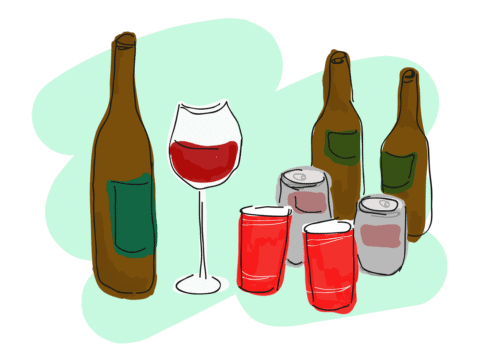Welcome Week can be an exciting time for students — there is an abundance of new experiences, new people and the first days of freedom for some. Amidst this action, there will undoubtedly be new opportunities to party and drink alcohol. Although there is nothing wrong with enjoying alcohol responsibly, it is wise to know your limits and how to consume alcohol safely.
Speaking on the issue of safe alcohol consumption is Rita Hanoski, the health education co-ordinator with Student Health Services, who believes that alcohol can be enjoyed safely but that it is important to debunk some myths about student alcohol consumption.
“Changing that norm on campus that not everyone drinks on campus, is a huge support to people that don’t want to drink,” Hanoski said.
According to the The National College Health Assessment, a study conducted annually on campus, 13 per cent of students say they never drink alcohol and 12.5 per  cent say they haven’t had any alcohol in the last 30 days.
cent say they haven’t had any alcohol in the last 30 days.
“So if you generalize that at any given time, there’s about 25 per cent of the student population that say they do not drink. They might just be taking a break or they may be abstainers. So 75 per cent of students drink, and less than half of that number is binge drinking. I think that’s an important message to get out,” Hanoski said.
She added that alcohol is not necessary to socialize and meet new people at university.
“It’s probably easier to relax and talk to people after drinking. But if you put some effort into getting to know a variety of people so you can go to a party without the need to [consume something in order to feel] relaxed first, that’s a good strategy as well,” Hanoski said.
Much like following the general food guide, Hanoski recommends following the alcohol consumption guidelines set forth by the Canadian Centre on Substance Abuse. Accordingly, one drink is defined as 12 ounces of beer, five ounces of wine, or one and a half ounces of hard alcohol.
“[The drinking guidelines] encourage, for men, no more than 15 drinks per week maximum, or no more than three per day. For women, it’s 10 drinks per week and no more than two per day. That’s something that they promote but also that they want students to be aware that there are guidelines for drinking in a low-risk way,” Hanoski said.
She also shared strategies to use in order to avoid overdrinking that don’t necessarily require one to abstain from drinking altogether.
“Water or soft drinks, eating before or during drinking [will slow down the alcohol], know the size of drinks, be the designated driver, only take as much money as the number of drinks that you want and the cab ride home,” Hanoski said.
Although Student Health Services does not discourage alcohol use, they want to inform students of the potential negative effects of overconsumption. According to the aforementioned study, 40 per cent of students that drank alcohol regretted their actions while under the influence.
Alongside bad decisions, Hanoski listed dependency and negative impacts on academic performance as effects of drinking more than the drinking guidelines. The Canadian Centre of Substance Abuse advises against consuming five or more drinks in one occasion for men and four or more for females. Hanoski calls more than this “high-risk drinking” — or drinking to get drunk.
This type of drinking can be of concern to students as many events and drink specials are aimed at students. That is why it’s important for students to think about their alcohol consumption and how it impacts health in order to maintain a healthy lifestyle. The U of S Student Health Services are available to any students either looking to evaluate their drinking habits or work on bringing their alcohol consumption down.
—
Jack Thompson / Staff Writer
Graphic: Lesia Karalash / Graphics Editor